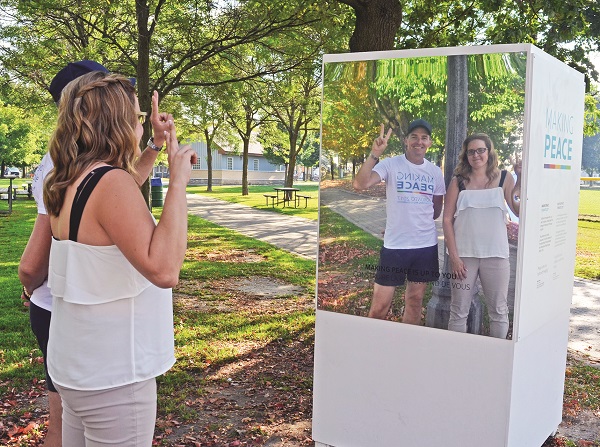General News » News
“Making Peace” arrives with timely message
September 27, 2017 · 0 Comments

By Brock Weir
After stops in Geneva, Strasbourg, Stockholm and numerous international cities along the way, including Toronto, Aurora might seem a humbler stop for the titans of world peace.
Truth be told, it probably is, but for curator Ashley Woods, it is a perfect location for Making Peace, a touring public art display incorporating over 100 iconic photos in efforts to achieving world peace, which challenges the viewers to think deep about what they can do to further the cause.
Mr. Woods was in Aurora on Tuesday helping to install the cubes that will form the Making Peace exhibition which, starting this week and running through November, will take pride of place at Town Park.
Unlikely, yes, but a significant reason for the acclaimed installation coming to Aurora can be found just a stone’s throw away at the historic Church Street School building because, within its walls, was educated Lester B. Pearson, the only Canadian to individually win the Nobel Peace Prize.
Earlier this year, Mr. Woods approached a several community bodies, including the City of Toronto and Heritage Toronto on activities they had planned to commemorate the 60th anniversary of future Prime Minister’s Nobel win.
They hadn’t but, as it happened, local organizers Shawna White of the Aurora Museum and Archives and Councillor John Abel came calling, and it seemed like an ideal fit.
To that end, the Grand Opening of the Making Peace exhibition will formally take place next month within the walls of Pearson’s boyhood school, now home to not only the Museum itself but the Aurora Cultural Centre with Pearson’s granddaughter as the guest of honour.
Making Peace is the culmination of the better part of a decade’s work on the part of Mr. Woods.
When he was working as a curator for the Red Cross Museum, he was approached by an organization for Nobel Peace Prize Laureates who were organizing an anniversary event in Geneva in 2010.
They wanted him to get involved, but his first question was the essential one: What is peace all about?
“They said that was a very good question but there was no consensus from the laureates as to what peace was all about,” Mr. Woods tells The Auroran.
So, he set about to answer his question himself, first calling Dr. Kathleen Sullivan, a peace educator with the United Nations. She agreed that from the UN’s perspective there is no clear consensus between member states on what constitutes peace. All angles, therefore, needed to be explored.
“I accepted the challenge and the result is Making Peace, explaining through photography what five necessary elements to creating a lasting peace,” he says.
The exhibition pulls together 130 photos spanning the immediate prelude to the First World War through to the present day.
It is an ever-changing show which is continuously updated to incorporate new developments on the peace front, including steps forward and unfortunate steps backward.
“As people walk through Making Peace, they will see the problems that exist around the world but they will also see images that show and try to convey solutions, including portraits of people who have done amazing work in the past and ordinary citizens who are just making a gesture,” says Mr. Woods.
Grouped by theme, the five essential elements have been boiled down to Violence & Disarmament, Conflict Prevention & Resolution, Economic & Social Justice, Human Rights & Democracy, and the environment.
“It is divided into five colour themes,” he explains. “You have this amazing rainbow effect with the exhibition. To create a sustainable peace we need to bring these five key building elements out. If one of those elements is missing, it doesn’t necessarily mean war will break out, it just means that peace is fragile.”
While Making Peace is open to the public, and the aim is to educate people on what peace is all about, organizers have tailored a guide geared towards local students on world peace and hope it will be a destination for schools across York Region to bring their students to learn more.
Indeed, some of that outreach to local school boards and private schools is well underway.
“In Toronto alone, I have given over 2,000 tours,” says Mr. Woods. “When you judge how successful the show has been, I think that can be judged from how easily and how accessible the photographs are to the young public and how easily teachers and students can use those images creatively in the classroom afterwards. There are pictures and panels in the show that introduce visitors to local partner organizations and the reason for that is young people can contact those organizations and, if they wish to contribute to the peacemaking process, be it planting a tree or looking at human rights or violence in their community.
“The exhibition provides a global view of peace but, at the end of the day, our aim is to get young people involved in bringing about a positive change.”
And the exhibition drives that home, putting the focus squarely on your shoulders.
As you stroll looking at images of Lester B. Pearson, Nelson Mandela, the horrors of the Vietnam War or the flower power that fought against that and indeed a generation, the last image you see might be a startling one.
“The last panel in the whole show is the most important panel of all: there is no image whatsoever, it is simply a life-size mirror. Kids look at themselves in the mirror and you ask, ‘What do you see?’ They say, ‘I see myself.’ ‘Why do you think that is important?’ ‘Because I’m the one that has to make peace.’
“Martin Luther King once said that unless you are part of the solution you are part of the problem. The message I want to get across is people need to become part of that solution.”
Making Peace runs at Town Park through November.











